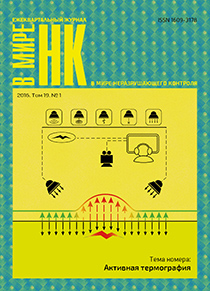employee
Tomsk, Tomsk, Russian Federation
Introduction. The paper describes some recent developments in the field of a novel nondestructive testing technique called local defect resonance. Unlike high power ultrasonic infrared thermography, this technique involves the analysis of resonant frequencies in defect areas under low-power ultrasonic stimulation. Method. In order to determine conditions for local defect resonance, the technique of laser vibrometry has been used to find resonant frequencies for defects of a particular geometry. Resonant frequencies are determined for impact damage in CFRP thus allowing to obtain infrared thermograms of such defects under low-power ultrasonic excitation. A sample made of carbon fiber reinforced plastic was ultrasonically stimulated in the milliwatt to watt power range. The frequencies which corresponded to local defect resonances were determined by means of a laser vibrometer. Results. Experimental results are presented for carbon fiber reinforced composite (CFRP). Images of both temperature and vibration amplitudes were obtained to demonstrate potentials of low-power ultrasonic infrared thermography. Practical application of this technique was in the inspection of impact damage in graphite epoxy composite. Conclusion. The main advantage of this technique is its nondestructive character at a stimulation point. It was shown that defect stimulation at resonant frequencies ensures damage-free testing procedure where temperature signals in defect sites can be reliably detected by contemporary infrared imagers. In some cases, air-couple technology also provides reasonable results of defect detection due to the resonant character of material excitation.
infrared thermography, ultrasonic stimulation, composite, impact damage
1. Solodov I., Bai J., Bekgulyan S., Busse G. A local defect resonance to enhance acoustic wave-defect interaction in ultrasonic nondestructive testing. Appl. Phys. Lett. 2011. V. 99. P. 211911.
2. Solodov I., Bai J., Busse G. Resonant ultrasonic spectroscopy of defects: case study of flat-bottomed holes. J. Appl. Phys. 2013. V. 113. P. 223512.
3. Mignogna R. B., Green R. E. Jr, Duke J.C. Jr et al. Thermographic investigation of high-power ultrasonic heating in materials. Ultrasonics. 1981. V. 19. P. 159-163.
4. Garnier J.-L., Gazanhes C. Visualization of ultrasonic vibrations in piezoelectric ceramics using telethermography. IEEE Trans. Son. Ultrason., 1978. V. 25. P. 68-71.
5. Migliori A., Sarrao J. L. Resonant Ultrasonic Spectroscopy. Wiley-Interscience Publ., New York, 1997.
6. Solodov I., Pfleiderer K., Gerhard H. et al. New opportunities for NDE with aircoupled ultrasound. NDT & E International, 2006. V. 39. No. 3. P. 176-183.
7. Solodov I., Busse G. Resonance ultrasonic thermography: Highly efficient contact and air-coupled remote modes. Appl. Phys. Lett. 2013. V. 102. P. 061905.
8. Solodov I., Derusova D., Rahammer M. Thermosonic Chladni figures for defect-selective imaging. Ultrasonics. 2015. V. 60. P. 1-5.
9. Timoshenko S.P. Vibration problems in engineering. - D. Van Nostrand Company, 4th ed., 1956.
10. Савельев И. В. Курс общей физики. Т. 1. Механика, колебания и волны, молекулярная физика. - М.: Наука, 1970. - 517 с. / Savel´ev I. V. Kurs obshchey fiziki. T. 1. Mekhanika, kolebaniya i volny, molekulyarnaya fizika [General physics. Vol. 1. Mechanics, oscillations and waves, molecular physics]. Moscow, Nauka, 1970, 517 p.





